#how to propagate basil
Explore tagged Tumblr posts
Text
Easy Tips to Grow and Propagate Basil at Home
Looking to enjoy a steady supply of fresh basil throughout the year? In this guide, I’ll cover easy tips to grow and propagate basil at home, ensuring you have a flourishing herb garden no matter the season. Whether you’re a seasoned gardener or a beginner, these tips will help you successfully grow and propagate basil for culinary and health benefits. The Benefits: Why You Should Grow and…
#basil care tips#basil cuttings#basil growing guide#basil health benefits#basil plant care#basil propagation#basil tips#easy basil propagation#fresh basil year-round#grow and propagate basil#growing basil at home#how to propagate basil#indoor basil growing#year-round basil
0 notes
Text










the current kitchen potted plant ensemble 🏡🌱🍅🌶️🪴
here's how everything in my kitchen window is doing rn! i just sowed new seeds for a sweetie cherry tomato plant & two catnip plants, so in total, the plants in the kitchen window are:
2 lemon drop hot peppers 🍋🌶️
2 black cherry cherry tomatoes 🖤🍅
1 basil plant 🌿
1 basil water propagation 🌿
2 orange hat microdwarf cherry tomatoes (but that will turn into 5 since there's several in each container) 🧡🍅
1 ground cherry 🍅🌱
2 catnip plants 🐈🌻
1 sweetie cherry tomato 🍅🫰
(plant names in image alt text, seeds from both @tomorrowsgardennc and bentley seed co)
#hobby: gardening#gardening#garden#gardenblr#garden blog#plantblr#plants#plant#tomato plant#pepper plant#cherry tomatoes#tomato#hot peppers#ground cherry#ground cherries#basil#catnip#kitchen#aesthetic#cottagecore#cozy#homey#urban homesteading#urban gardening#urban#homestead#homesteading#seedlings#seed starting#seeds
51 notes
·
View notes
Text
Harvesting & Processing Basil
Finally! The long-awaited basil post! I wanted to wait until the process was completely finished before putting this together. I deeeefinitely made some mistakes, as you will soon realize.
Part I (October 9): Harvesting the Leaves
I didn't take a picture directly before the harvest, so these ones from 12 days prior must suffice. This is more or less what I started with:
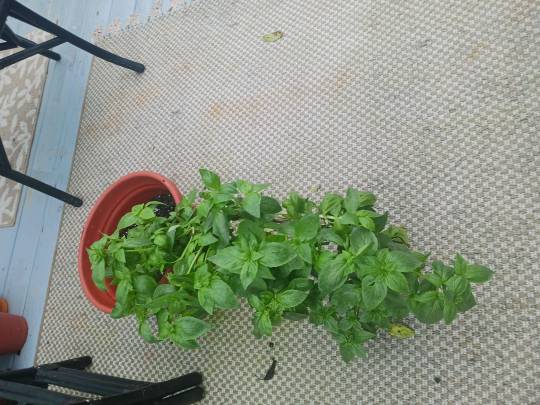
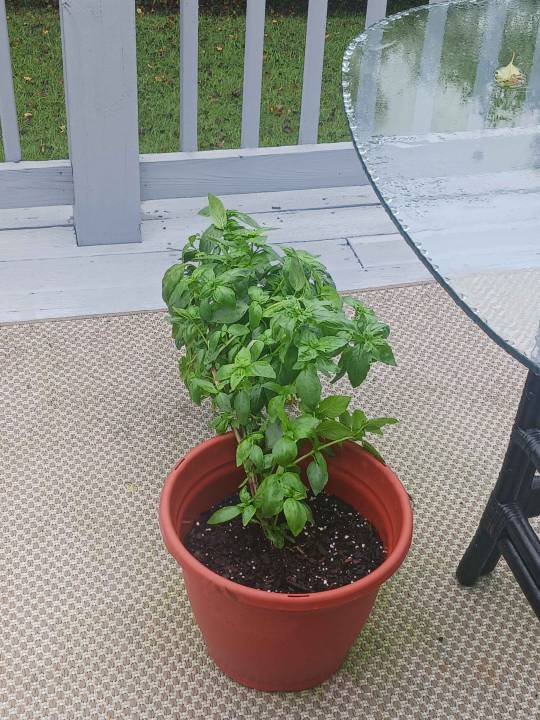
As you can see, it's a fairly healthy plant, albeit smaller than you might expect. My first attempt at basil died in July, and was replaced in August with a cutting from someone else's plant that was being given away on the local freecyling facebook group. I was pleasantly surprised to find out it the cutting had roots, so I planted it and this is what it became in ~ 2 months.
I wasn't originally planning to harvest on any particular day. It was more like I just, on a whim when I got home for the day, grabbed some kitchen scissors and went outside to cut some leaves. I was originally only planning to take a few, leaving some to grow. That was, until I discovered that the plant was flowering. If you don't know already what basil looks like when it flowers, here are some pictures! If you don't know, basil dies after it flowers. (At least that's what I've been told) So when i saw this, I knew I had to go ahead and harvest the whole thing. There is also a photo at the end of the flower/seed pods that are precursors to the flower. I had never understood how the ends of basil look different when they're growing new leaves vs. about to flower until I saw this. Now I know what to look for.
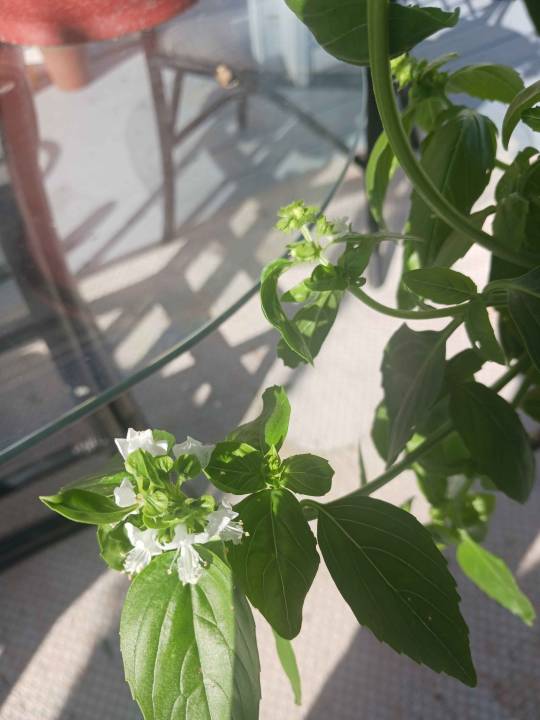

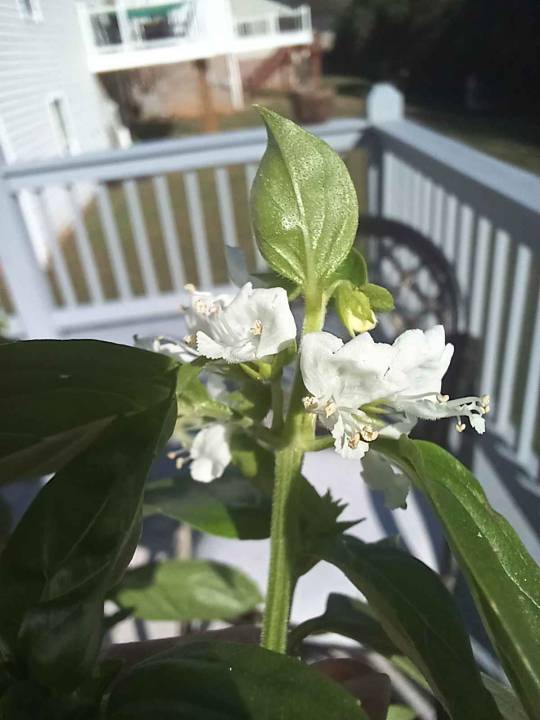


I was texting a boy basically the entire day while harvesting, so it took several hours longer than it needed to, because I kept pausing to type on my phone. I went out at like, 3pm, and finished + came inside around 6-7pm. Yes, we are dating now.
This is what it looked like at the halfway point, when I was just laying all the stems in a pile and collecting small leaves in the strainer:

That is when I realized it was hubris to have such a small vessel, so I grabbed a large mixing bowl from inside.
This is what the plant and both bowl & strainer looked like when I finished picking off of the main plant:

I was... shocked, haha. I did not expect the stems to have so much volume when picked. As you can see, I left some leaves at the end of the plant where there were flowers, so that I could enjoy them for a while longer until they withered. Also left some "undesirable" (by me) leaves behind on the woody stems.
The next step was to separate the leaves from the stems. Remember, I was winging this whole process and not thinking ahead. Otherwise, I might have been pulling off the individual leaves from the start. I got this setup, with a paper towel for a working space, and a slightly smaller mixing bowl as the receptacle for stripped leaves. I used bag clips and the weight of the bowls to prevent the paper towel from blowing away:

For the most part, I just relied on my fingernails to cleanly break the leaves from the stems, then threw the stems to the back of the paper towel and the leaves into the bowl. I only had to use the scissors a few times, especially for cutting off pieces of leaves where bugs had begun to eat them, or they were extremely yellow, but I wanted to still use the green part. Here are some process photos, including a couple of tiny heart-shaped leaves. There's also one leaf where, when I cut it, just the clear strip of cellulose remained where the rest of the leaf had been, and I thought it was cool that I could see through it.

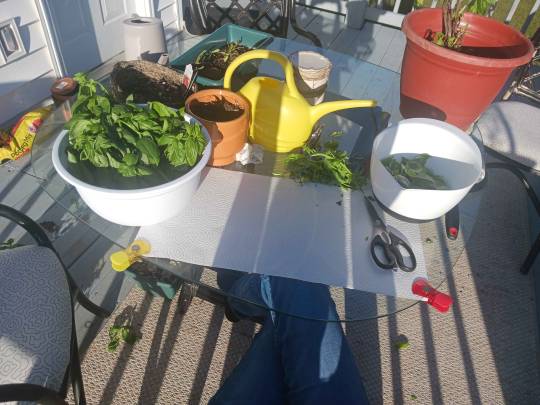

When i was done, I threw the stems back into the planter. With the stems removed, everything fit in the smaller mixing bowl just fine. Since the basil was in the planter for only ~2 months, the plan is to remove the roots and re-use the dirt for something else (like giving more space to + propagating my African Violet! Which is something I've been wanting to try lately. I already saved an egg carton to potentially use for starting the leaves.
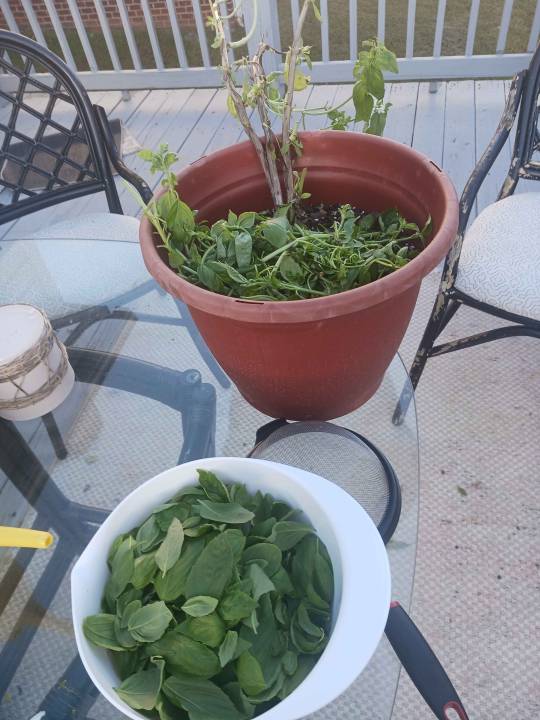
Part II (October 10): Washing & Drying the Leaves
I was going to wash the leaves and lay them out to dry on the same day, as I believe is recommended, but I got lazy LOL. So I returned the following day. I started by putting leaves in the strainer and rinsing them under the faucet, but quickly realized that that was going to be annoying and take forever. I finally decided that the most efficient course of action was just to fill the bowl with water so that everything got soaked. I used warm water, with no solution or vinegar or anything added.


I got an extra large baking sheet and put down a paper towel on it. I had just begun pulling leaves out of the water and laying them out on the paper towel when I realized that this was too much water involved. I fixed the issue (somewhat) by pouring all the wet leaves into the strainer and shaking it gently to remove as much moisture as I safely could, then set it down to let it continue to drip down into the bowl while I worked. Setup A vs B:


Although I started off trying to make sure everything was evenly spaced, I had roughly 14 layers of paper towels to put down so I eventually faded into chaos, as every ADHD gardener is wont to do. Some vague asf process photos & what the stacks looked like:
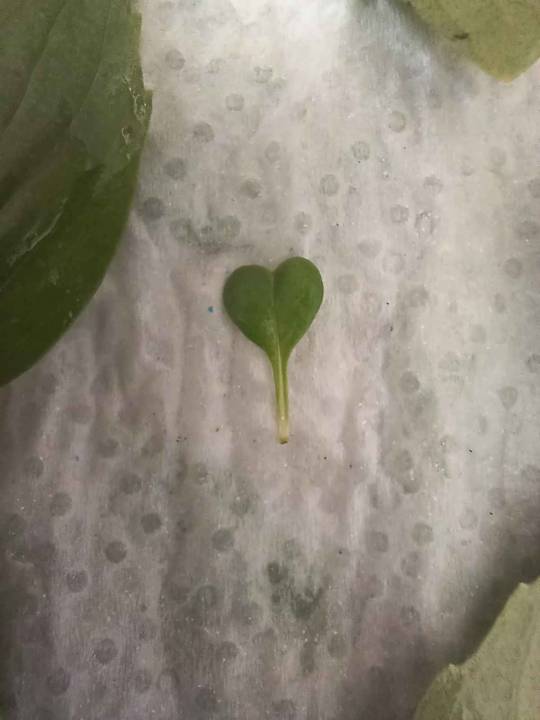

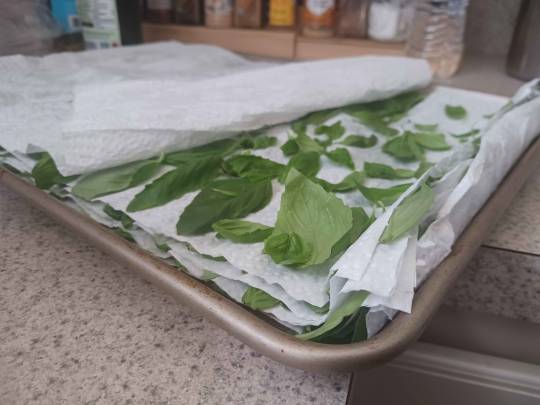
I let it sit for a few hours while I cleaned out my food dehydrator. Now, this is the part where I Completely forgot to be taking process photos, so Unfortunately, I don't even have any pictures of the dehydrator to share, except for this product photo of the model that I was using:

I laid out all of the still-slightly-damp leaves in all of the trays, trying to keep them evenly spaced and not overlapping but (kind of) failing. Then I shelved it to wait overnight for the leaves to air-dry. Had I been doing this properly, I would have let the leaves sit on the paper towels, in a single layer, instead of stacked up or in the dehydrator the way I did.
Part III (Several Day Period Oh My God): Dehydrating the Leaves
It is utterly embarrassing how difficult it was to get these leaves dry. The recommended temperature for basil/herbs is 95 degrees Farenheit, for 12-24 hours for basil. I started off at the lowest dehydrator setting, 100F, for 13 hours and started it overnight.
In the morning, two of my three roommates were complaining about the smell and asked me to move it outside to the porch (direct sunlight) I obliged, and seeing as the basil was still thoroughly damp, added another 6 hours on.
Then I forgot it overnight again. *sigh*
I brought it back inside and realized that all of the leaves on the top were brown (albeit mostly dry), but many of the leaves at the bottom were still wet. This is when I posted my cry for help on Tumblr dot com, and was told to not put them outside again.
Unsure what to do and overwhelmed by other tasks, I pretty much gave up. I ran it for roughly 12 more hours indoors a day or two later as a last-ditch effort, but didn't check it right away.
October 22nd was the day I finally took the time to check the leaves and I was immensely and pleasantly surprised to find that almost all of the leaves were dry! I knew that it had likely been exposed to moisture in the powered-off dehydrator, so I ran it for 2 hours just to get rid of any atmospheric moisture and then set to work on grinding it up.
Part IV (October 22): Processing the Dried Leaves
This was, honestly, the second-most-fun part of the process immediately after the harvest. It was a little bit tedious, but I still enjoyed it. It's also when I started taking pictures again.
First of all, I spilled several leaves onto the floor while trying to empty the trays into a small metal mixing bowl that I was using to collect the dried leaves. Unfortunately, they had to be swept away because our kitchen floor is dirty.
A week or two earlier, I had washed out an Old Bay seasoning container, anticipating putting ground basil in it. I know that whole leaves preserve the flavor better, but I am working with what I can here!!! This is what worked best for me this time. My roommate Lilly has a tiny asf mortar & pestle that she allowed me to use, so I washed it out. I grabbed a funnel for the Old Bay shaker, and set up shop at a foldout table right in the middle of the kitchen floor. I put on the podcast that I'm currently working through, a Behind the Bastards miniseries titled Behind the Police. It was released in summer of 2020 and is all about the history of the institution of police in the USA. Super interesting.
This was the setup:

So, the way I did this was, I would gather a few leaves at a time into the mortar & pestle, grind it up in a circular motion, and then pour the ground basil into the funnel and the Old Bay container. Pretty simple and straightforward.
A few leaves in the bowl were still damp/limp, and wouldn't crumble in the mortar & pestle. I just removed them as I went. I included the brown leaves from the top tray because, at this point, I was just happy that I wouldn't have to throw everything away.
This is what it all looked like when I was done! As you can see, only a few leaves had to be removed.


Part V: Conclusion & What I've Learned
It's absolutely incredible to me how much those leaves at the start reduced, until they only filled a tiny handheld bottle!!! Yes, that is ALL of the leaves!! To drive home how insane this is, here is a side-by-side of the initial harvest of leaves-only, and the bottle that it filled at the end:


Just crazy! It's a bit hard to comprehend the scale from these pictures, honestly.
From there, it was just cleanup and storing the dehydrator, then writing BASIL
basil BAsil. BASIL
BASIL. BASIL
all over the Old Bay container so that it wouldn't be mistaken.
The plan if i didn't have enough room in the bottle was to portion out & give away bags of whole leaves at the punk rock market, like I've been doing with zines (oh! that's something I haven't posted about!). I was slightly disappointed that I didn't have enough, to be honest
Going through this process has given me an insane amount of increased respect to spice harvesters both currently in the spice world, and throughout history. It's a LOT of work to harvest & process just one bottle of basil! It's like that one post talking about how our ancestors are probably proud of us, or at least happy for us, to be surrounded by spices and luxuries that previously were only available to the rich and powerful.
Also as someone with Indian heritage, which is known for its spices LOL, this honestly felt like it connected me a little bit with that culture that I wasn't raised in. Not in any crazy metaphorical way, just coming to appreciate the process and work that goes into spice production, in a way that I wasn't able to before going through this process. The significance of spices carries more weight for me now.
I don't think I'll be able to use all of this basil before next year. I honestly don't even cook with dried basil that often, it's just nice to have fresh basil. What I might do is manage a plant again next year, for the gardening experience, then just straight-up give away fresh & dried basil at the market like I was originally planning to this time. I could plan it a little bit better, though, to ensure that I can feel confident in the quality.
8/10 enjoyment. Tedious & frustrating at times, but ultimately very rewarding, and mostly fun! This is the first, and likely only, harvest I've had this year in 2024. I look forward to expanding next year!!! I can't wait to see what I'll grow then. Time to start planning, I guess!
#gardenblr#garden#gardening#greenery#plants#basil#spices#spice harvesting#harvest#harvesting#dried herbs#herbs#herb#drying herbs#dehydrating#food dehydrator#dehydrating herbs#container gardening#is that the right tag?#micro gardening#backyard garden#porch garden#subsistence#herb farming
20 notes
·
View notes
Text
Me: Ah, I only have two pots of basil this year, so I probably won't have enough to make pesto.
Meanwhile, the power of having moved somewhere with a full sun patio:
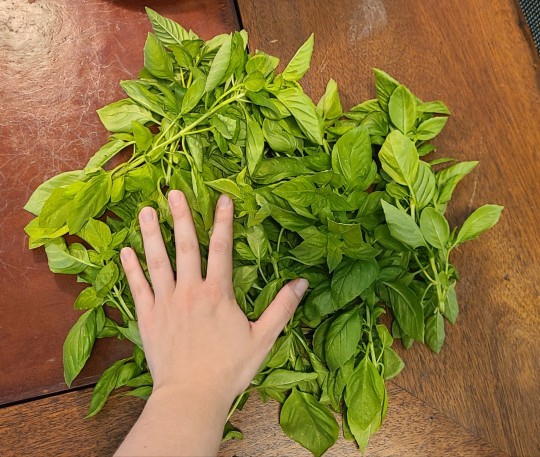

I didn't even finish pruning the plants! I left a few stalks because I usually prune off a stalk or two every week to use on my eggs every morning for breakfast. I just had to give them a heavier prune right now because they were trying to flower. Despite that, here's how the plants look AFTER pruning:
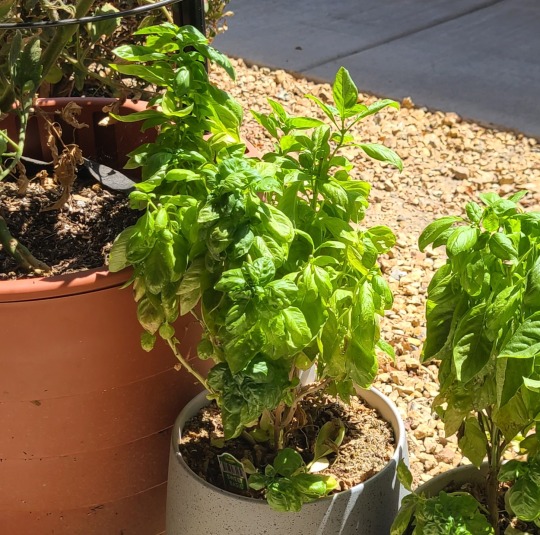
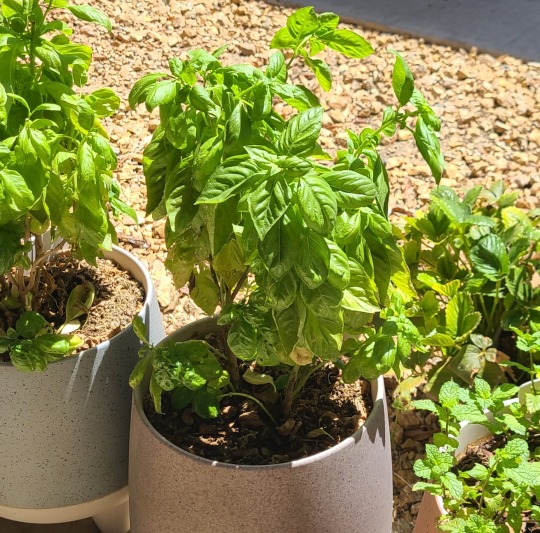
Ah, how far they have come from where they began. This all came from one little cup of basil I bought at the garden center and then propagated cuttings of into two separate pots.

Anyway, I'm deeply pleased to have the chance to make more pesto this year. The homemade stuff is always SO good. I'm also going to be trying it with walnuts instead of pine nuts this year, so fingers crossed that turns out well!
Year two of basil and it is the gift that keeps on giving. There's an old lady that walks her dog past my patio sometimes and earlier this week I was clipping off a couple of cuttings when she saw me and complimented my plants, saying that she loves basil. I gave her one of the cuttings and she was delighted. Basil for everyone!
33 notes
·
View notes
Text
List 5 (or more, or less) of your nonsims interests. These can be hobbies, shows, books, other games, etc.
Thanks for tagging me @simscici 💛
Music – I'm always listening to something. I also enjoy making my own playlists (the main one has grown into a bit of a monster, to be honest). Music is just part of my everyday life. According to Spotify, I listen to more music than 96% of users in my country. Quite possible, because I sometimes listen to music from the moment I wake up until I go to bed. 😂 Back in school, I used to be an assistant at the school radio. Our so-called DJ was this guy who knew everything about music. He was a walking encyclopedia. We had a challenge to find a song he hadn't heard before. I think that's when my obsession with digging for new music really started. And let's be real, this was the era of Winamp and torrents, and every download was a gamble between discovering a new song or a virus. 😅
Cooking – I used to work as a cold kitchen chef for several years, so cooking is still something I really enjoy. I care a lot about plating and the little details. I hate boring white plates. I collect all kinds of ceramics, and I'm constantly switching up which dishes I use. I really believe a good meal starts with your eyes. And why shouldn't you treat yourself to a restaurant-style experience at home.
Baking – My username is based on facts. 😂 I'm a trained baker-confectioner. I love making cakes and desserts, and I also know how to bake naturally leavened bread, like rye loaves and sourdough. Every year, I make different flavors of meringue kisses for my family and friends for Christmas. Their absolute favorites are malt meringues and orange meringues.
Puzzles – Jigsaw puzzles are like a full brain reset. It's literally the only activity that completely shuts off all my other thoughts. It's a kind of meditation, I guess.
Plants – I've always wanted a home full of plants. My last apartment had mold issues, and the only thing that survived the damp winters was my monstera. When I moved, I took it with me, and now, that same plant is growing in eight different homes and two offices because I've propagated and shared it so many times. I've got a growing collection of other houseplants too, and they're all thriving now. Except for one that my cat loves to chew on. I also have a Click & Grow smart garden where I grow edible plants. Nothing beats the taste and smell of the basil you've grown yourself. 🤤
If you're reading this, consider yourself tagged. 💛
19 notes
·
View notes
Note
AITA for getting back into gardening?
There’s a story to this I swear I swear.
So. My friend got introduced to the game Omori! I’ve been a fan since it was in development and have been slowly trying to convince them to play the game to have brainrot with me.
And, like many people, my friend grew to love the character Basil when they played it. He’s a shy, sweet boy who loves plants.
My friend has now entirely changed themselves and acts as if they are pretending to be Basil in real life. They bought new outfits that mimic the ones he wears, they’ve suddenly started growing plants, etc. it’s very strange.
This is totally fine may I add! Baffling, but it’s not hurting anyone and I am actually very happy for them if this is genuinely how they want to express themselves. What is not okay is how they’re… trying to stop me enjoying gardening..?
I love plants and after a longwinded medical issue, I’m feeling less shitty I’m back into it actively. I have a thriving aloe vera with babies, cacti, succulents, a fig tree, apple tree, pear tree, herbs, raspberry bush, blackberry bush, loganberry bush, tomatoes, potatoes, etc etc. you get the picture. I really love plants! And I decided since I’ve been feeling better, hey, why not plant some new stuff too? So I’ve got some sprouts of various plants growing.
As I enjoy plants and they also do, I figured it’s a good common thing to bond over! I thought since they were a beginner I could help them when they got stuck or needed advice. So I’ve been talking to them a lot about their plants, offering some stuff to them when I harvest it, like strawberries and raspberries and apples, etc. and also being a generally open person if they need advice.
I have discovered over the past month or three that it seems my friend can not keep a plant alive to save his own skin. It’s okay, he’s new to it, plants die, it’s life. But when I offer some help (eg: “take some of my flower food, it will really help you get more blossoms when the time comes,” “you need to prune this part, it’s dead and it will spread to the rest of the plant”) he acts like I’m speaking down to him or insulting him. And he keeps killing plants.
Eventually I actually got upset with the amount of plants he was killing. They are living things and deserve a fighting chance, just like any person or animal does. There is no reason not to treat a spider plant with the same care you would a tree. So I was like hey if you want I can help you set up a watering schedule / help you find out which plants need more shade or more sun and stuff so you can keep them alive longer and he just blew up at me. I’m talking like screaming that he knew what he was doing and it’s NORMAL for plants to die and i “didn’t even care about plants until [I] started so why are you copying?!” It threw me for a loop and actually made me cry because you know… I don’t like getting yelled at lmao. After I cried a little bit I told him that I wasn’t going to talk to him until he apologises for treating me like that because it was uncalled for and really hurtful, I was only trying to help him with his hobby so we could talk about plants together and maybe share some propagated sprouts or something when his plants were old enough. He complained about me online for about a week but no one really listened because it’s very common knowledge I’ve been gardening since I was literally about four years old. He’s since stopped complaining about it but still refuses to apologise.
I’m worried that I might have been an asshole by offering my advice and help? I never pushed it onto him or anything, just offered helpful tidbits and gave him some plant food once, but he might have taken it in a different way than how I meant it.
AITA?
~🌿
What are these acronyms?
108 notes
·
View notes
Text

It's my rest day so not doing much in the garden except checking on things and some light harvesting. Pulled a few Pink Beauty radishes to give the dill and cilantro a little more room. The chickens went nuts over them (unfortunately I don't like radishes no matter how tasty they look).

I did get a second harvest of Chinese broccoli today, enough for a side serving for dinner.


The tomatillos are already flowering and it's a bit comical how different the flowers are between the two varieties. Not sure if cross-pollination for fruit production is going to work. I'm down to four plants now--a cutworm or something took out the fifth seedling at the soil line. The squirrels stole all the fruit last year (after the flea beetles tried to wipe out the seedlings) so I was hoping to get some fruit this year.
Speaking of squirrels, interrupted one trying to dig up all my Chires Baby corn on the front porch. So now those two containers have the top part of a guinea pig cage protecting them. It killed one nasturtium and damaged two corn seedlings (we'll see if they recover). There's still plenty for pollination, though these are meant to be harvested in the baby stage. Might let one or two ears mature for seed, but I do still have enough from last year so we'll see.

In good news the Mammoth Russian sunflowers and sweet annie are doing really well. I did transplant the extra sunflower seedlings (four) from the direct sowing part to their own spots in my greed to keep all of them instead of thinning. I'm putting the pots over those at night, but leaving the foot tall ones (and the sweet annie) exposed now. So far so good...

Passionfruit vine is returning! It's in the new strawberry bed in back and I'll be able to direct the vines to climb up the sunchokes and fence panel trellis in the adjacent bed.

I'm also surprised to see just how much wild white aster reseeded in the side yard. The bees are going to love this in the early fall.

In propagation news, one of two French tarragon cuttings has taken, which is fantastic. Just doubled my gain from the one plant I had to purchase this year. Will get this into it's own terracotta pot and into the cold frame soonish.

But also having success with the other cuttings. Took their little humidity-raising baggies off yesterday. Two of the pineapple sage (front) look great, one is struggling. All cuttings of Thai Sweet basil (rear two pots) are doing fantastic. I have found that this variety of basil is really yummy in scrambled eggs, so I plan on a few more rounds of cuttings to keep it going through the season.

And finally the cardinal climber I sowed last week is up. I think I'll transplant it to grow up the wire fence trellis in front when it's ready, one for each end to spread towards the middle.
#gardening#garden harvest#garden pests#germination#propagation from cuttings#going to try to do some garden construction work tomorrow#at least get the doors built for the raised bed enclosure even if i can't hang them until i find some hinges#maybe i can just hook them on somehow temporarily#i'll think on it
2 notes
·
View notes
Text
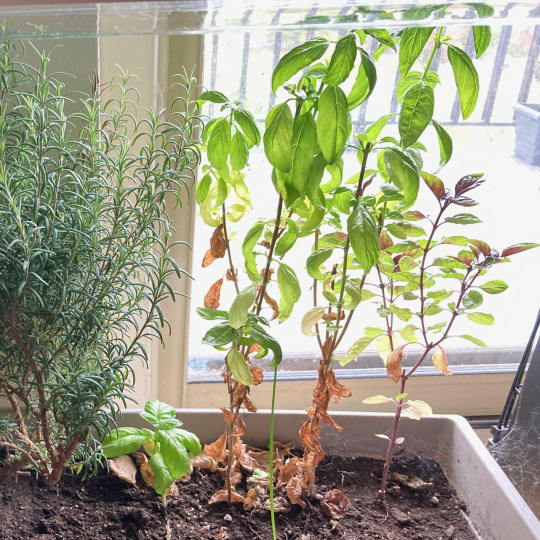
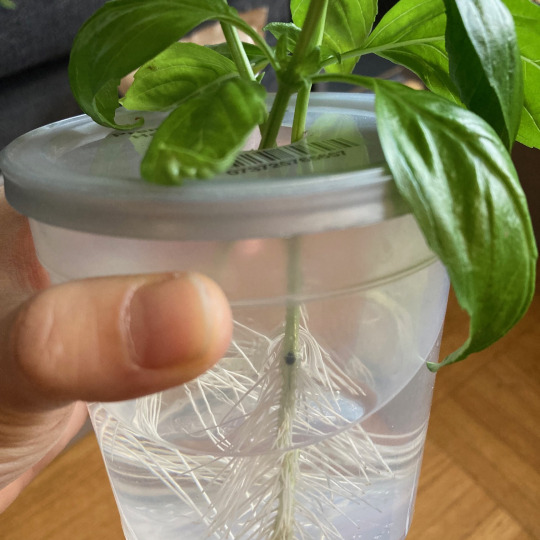


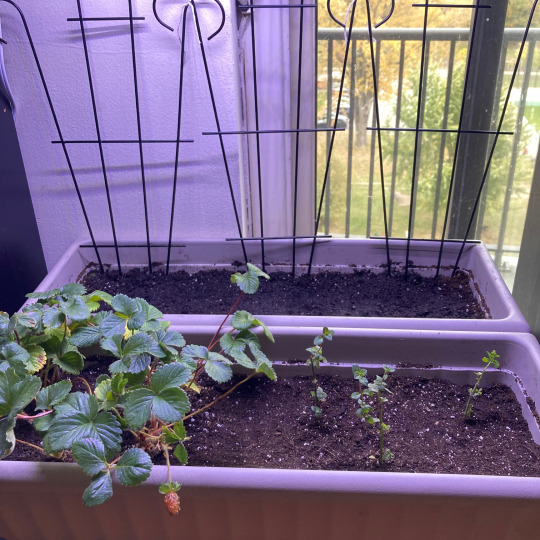
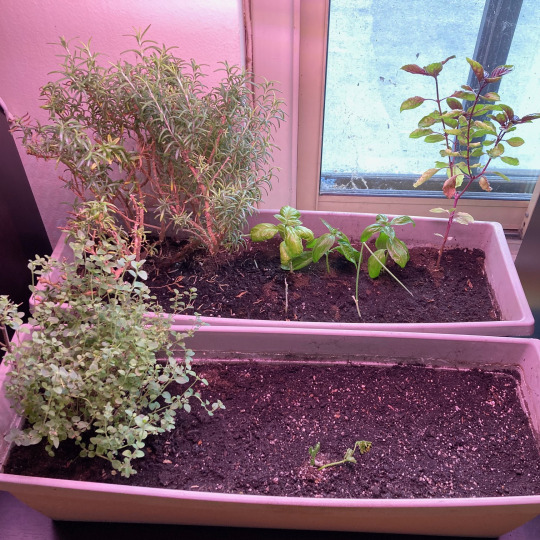
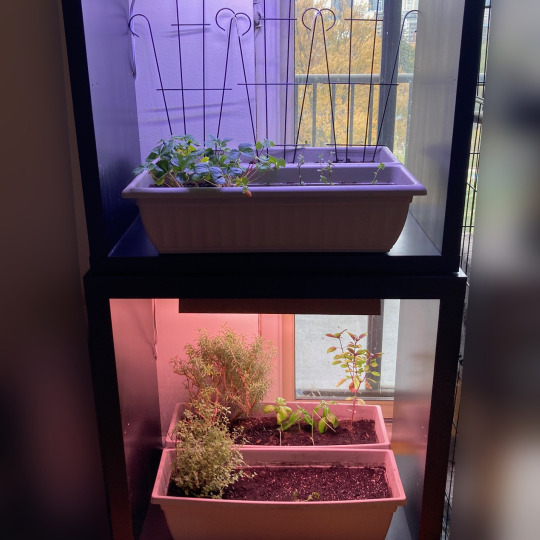
Looks like it is time to propagate the basil.
After a week or so, the basil cuttings have grown a lot of healthy roots.
I bought another IKEA Kallax shelf for the second tier of the garden, along with another set of Feit Electric LED grow lights. I used adhesive velcro strips to stick the lights to the top of the shelf, which has worked for the most part. One side of the top tier light got unstuck so I've had to secure it with string instead. We'll see how long the rest of them last.
Cat tried to supervise my gardening efforts, but then he fell asleep.
The top tier of the garden. The front planter has the strawberry plant and mint cuttings I've transplanted from the balcony. The back planter has trellises for the Sugar Ann snap peas and Tiny Tim cherry tomatoes I've seeded.
The bottom tier is the same as before, primarily herbs. The basil cuttings have been planted at the back, and the front space will be for experimenting with cilantro.
The 2-tier garden completed.
25 notes
·
View notes
Text
i was repotting basil earlier today and, as i was thinking to myself about the smell of dirt... well, this is a stretch of a headcanon (actually it's a headcanon on fanon, as we don't even know if regis canonically likes gardening, but it's just presumed that, he's got to get the herbs from somewhere, right?)
anyways, i wonder if regis has any particular relationship to plants, and gardening, and things with roots, or that are roots (like mandrake) owing to how he was buried in the ground for half a century. because, you know. when you plant a seed or a bulb, or plant propagated stems, you're also burying something in the dirt... in the darkness... to soon sprout in life anew...
#regis: so they buried me in the ground | angouleme: like a potato | regis: ...... like a potato.....#my biggest question continues to be if he came back from his bodyless head or his headless body. i have a headcanon but i'll never know#c: regis#the elbow-high diaries
11 notes
·
View notes
Note
Hello! I love reading your posts. I wonder if there are any food plants you can grow in a dorm room? Esp as a beginner. Like even herbs or something. Everything I grow dies 😥 I read that coriander is sturdy and even that died lol.
You can definitely grow some herbs- if you have enough light, and people tend to under estimate how much light these plants need to be healthy. Consider that they're getting several hours of direct sunlight outside during the summer, and then consider that they're indoors during the winter, when even outdoor light is far less intense. (of course this all depends on climate) A south facing window *might* be enough, but some kind of LED or compact florescent light is often a good idea. Look for a color temperature of 5000k or higher, but they don't have to be the super expensive ones. I would recommend starting with something that you can propagate after eating most of it, because people often find starting from seed intimidating or difficult. I really do think green onions are a great place to start, just cut off the root end with between half an inch and an inch of the base, put in soil, give as much light as possible, and keep evenly moist. Basil, Perilla, and Vietnamese coriander are also great- if you've got enough warmth and light for them. Try coriander from seed again once you've gotten some practice at keeping the others alive.
Hope that helps!
8 notes
·
View notes
Note
How about ✈️🌴💛🤩👨👩👧👦 for Lucy and Mae, and Saoirse and Zoe
Thank you soooo much for asking about my girls! It's been so nice to get a chance to work on them a bit more, these questions really helped! Sorry it got so long, cut to save your dash!
✈️ AIRPLANE — does your oc like traveling, or do they consider themselves a more homey person?
All four of them enjoy traveling, but to different extents and in different ways.
Zoe is probably the most passionate and in love with traveling out of all of my girls, She grew up in a very restrictive, very controlling religious family (think a religion that is commonly considered a cult) with a mother who ruled over everyone with an iron fist. For most of her life, her life consisted of: school, bible study, youth group, church, prayer and that was it. No friends, no parties, if she ever got to go on a trip it was a mission trip. Being able to travel represents all of the freedom she was denied and she would do it constantly if it were up to her. She's grown to love being home with her girlfriend and their friends, and she does get to travel a ton when she's on tour with fables so she's happy to compromise and not run off to backpack around the world for a year at a time but that would probably be her dream.
Saoirse likes traveling a lot, but she needs some time to unwind at home and center herself after a trip. She's definitely not ready to immediately get up and go right after they've gotten back like Zoe is (and backpacking around the world without getting to come home, see family and friends and relax for a bit sounds like hell to her). She loves getting to travel when fables tours, and loves her trips with her girlfriend but home is such a safe, comfortable, happy place for her and she treasures that as well.
Mae really enjoys traveling but she tends to prefer closer destinations, especially ones they can drive to or take the train to. She loves a good road trip, and isn't as big of a fan of planes generally. She's more willing to do longer, farther away trips when it's just her and Lucy - once they have their baby, they put a moratorium on long plane trips for a while because the idea of dragging a baby/toddler onto a plane with them sounds like hell to Mae.
Lucy loves traveling, especially to exotic locations where she can explore new cities and immerse herself in the local culture although she's really grown to love a good road trip with her wife as well. She just really loves new experiences, she never wants to go to the same place twice - that's boring. She'd be perfectly happy to travel with their baby, but she's happy to acquiesce to her wife and not put the family through that until they're past the baby and toddler stage. She does like being home as well, she couldn't travel all the time... she'd miss her little brother too much.
🌴 PALM TREE — does your oc have a green thumb? do they enjoy gardening?
Saoirse used to have a black thumb and would kill every plant she ever touched, but then Julian gave her a cutting of one of his favorite plants and she couldn't let her best friend since middle school (if not earlier) down so she had to learn how to care for it and make sure it thrived. He helps her learn how to propagate and eventually repot it (she covered the pot in googly eyes), and is always up to help her troubleshoot if her plant isn't looking its best or growing well.
Zoe is very much not a plant person. She's not great at caring for them (she's accidentally killed multiple pots of basil) and just isn't especially interested in learning how to beyond being able to keep Saoirse's plant alive if she can't for whatever reason or is out of town, because she knows how important it is to Saoirse and would never want to let her girlfriend down.
Lucy loves gardening and has such a green thumb. She dreams of retiring someplace in the countryside where she can have a big plot to grow flower and vegetables and herbs on, but until then she makes do with the space she has and mostly sticks to houseplants and herbs, with a couple of raised beds for flowers in the very small backyard of their brownstone. Her favorite thing to do on mornings where she's not scheduled to work is to wake up late, then spend a few hours tending to her plants with a cup of coffee while Mae reads on the patio.
Mae can keep plants alive (and will help Lucy out if she needs it), but she's really not interested in gardening or keeping house plants. She's happy to listen to her wife geek out about it and talk about her babies, but she doesn't want to do it herself. It's just not a hobby she enjoys very much - she doesn't like getting dirty, doesn't like weeding, doesn't like having to do manual labor outside when it's hot. It's just not her thing.
💛 YELLOW HEART — how many languages does your oc speak? what language(s) are they learning, if any?
Lucy's native language is English, but she also speaks Spanish. If we're going based on the CEFR scale, she's at the very high B2, low C1 level. She's not going to be mistaken for a native speaker, but if she had a patient at work who only spoke Spanish, she would not need a translator. She's working on improving her Spanish with a private tutor and a group of native speakers she practices immersion with, but is also working on learning some ASL so she can communicate more easily with Mae's sister when they all spend time together.
Mae's native language is English, and she's fluent in ASL. Her sister is Deaf and the whole family learned so they could communicate with her. Mae often ended up being with her sister's interpreter with people outside of the family, so she got really good at it. She's also learning some Spanish with her wife. She's likely never going to be fluent, but she's getting close to conversational in it and would like to be able to use it at a low level professionally in the future.
Zoe only speaks English, but she's really interested in languages and is trying to learn a few at the same time: German, French, Italian and Japanese. Is it the best idea to try to learn four languages at once? Probably not. Does she care? Absolutely not. She's really not shooting for fluency at this point, she's just having fun exploring a new passion.
Saoirse grew up bilingual, speaking English and Italian (one of her father's side of the family is Italian and when she was younger her grandparents who only spoke Italian lived with her family). She lost quite a bit of her Italian when they moved away and she wasn't using it on a daily basis, but decided to pick it up again as an adult. At this point she's probably in between B1 and B2, but intends to get back to full proficiency with it. She's also picked up a little bit of French because Julian's fluent in it, and is learning more bit by bit. She's not super serious about it, but would like to become fully conversational.
🤩 FACE WITH STARRY EYES — is your oc a planner, or are they more spontaneous in their actions?
Zoe is 100% spontaneous and chaotic; She does not have a planning bone in her entire body. She can force herself to sit down and make actual plans if absolutely necessary, but she's gong to hate every single second of it.
Saoirse's the planner in their relationship. She doesn't insist on everything being planned, and is pretty easily able to be spontaneous when it makes sense without being anxious about it but someone has to keep both of them alive and functioning and it's not going to be Zoe.
Mae and Lucy are both more on the planner side of things but Mae's able to be spontaneous and doesn't mind not knowing what's going to happen sometimes, and Lucy's not. She gets a bit anxious when she doesn't know what the plan is or when they're trying to play something by ear. She's so much more comfortable not leaving things up to chance.
👨👩👧👦 FAMILY WITH MOTHER, FATHER, SON AND DAUGHTER — how many people are in your oc's immediate family? how many people are in your oc's extended family? do they have aunts, uncles, cousins, grandparents, etc? who in their family are they closest with? are they close with their birth family, or do they have a found family?
Zoe's immediate biofamily consists of her, an older brother, an older and a younger sister, her mother and her father. She has an aunt and an uncle on her mother's side, and two aunts on her father's side, as well as about 10 cousins. Three of her grandparents have passed, but one is still alive. She's really... not in contact with any of her biofamily except for her older brother because they're all still part of the cult. She and her older brother are the only ones who've gotten out, and she's so close to him. The rest of them don't even know where she lives and haven't since she escaped after she graduated from high school. Her family is pretty much all found family - she has Saoirse's parents, Clare and Ana (Julian's aunts), the entire band and their partners, and a few of the other stylists she works with but especially Jasper and Marley.
Saoirse has a tiny biofamily but they're all incredibly close, emotionally if not geographically. It's her and her dads, her grandparents, an aunt on one side and an uncle on the other side and a single cousin who's the daughter of her aunt. They didn't live in the same place growing up, but Saoirse's always been really close to her cousin. They'd see each other at occasional family events and were always on messenger and texting each other growing up. Saoirse considers Julian's aunts, Clare and Ana, like her bonus moms. She's known them since she was a young teenager and is so close to them, especially Clare. She considers the rest of the band her found family as well, but she's especially tight with Lachlan and Avery.
Mae's immediate family consists of her, her parents, her younger sister, and an older and younger brother. She's got a big extended family, with multiple aunts and uncles on both sides, and what feels like countless cousins. They're all pretty close (except for a couple of them who are just... weird but doesn't that happen in every family) and throw big family events and reunions every year. Besides her wife and her brother-in-law, she doesn't really consider herself as having a found family. Lots of very close, wonderful friends she'd do nearly anything for? Absolutely. But not quite family. Her biofamily is her family.
Lucy's immediate family is her, her mom and dad and her little brother, Elijah. She's so close to Elijah and always has been - she was 12 when he was born and immediately decided he was her baby which was good because their parents were really hands off and uninvolved with him. Sometimes she feels more like his mom than his sister, but they do have a really close, respectful adult relationship. She's not close with her parents at all, because they've always treated her as the golden child compared to her brother and she hates it so much. They're barely involved in her life and she's always tempted to cut them out entirely. She's got two aunts and an uncle (as well as their spouses), and five cousins but she's really not close to any of them. They've haven't really stayed in touch for over a decade but they all think it's appropriate to text her to demand medical advice and she's just SO not here for it. As far as she's concerned, they're strangers and this is unethical. She is absolutely a found family and hers is: Elijah, Alexei, Mae's family (especially Mae's mom and sister), and some of her hospital colleagues (Rian and Brennan by extension, Viola and Sophie especially).
#oc ask meme#asked and answered#my ocs#oc: saoirse#oc: zoe#oc: lucy#oc: mae#thank you!!!! so much!!! for loving my girls#i know i've had a bad tendency to neglect them and i'm really trying to change that bc i love them SO much#i appreciate all of your lovely asks so much 🥰🥰
3 notes
·
View notes
Text
Does Rosemary Aid Memory?

Could rosemary be the answer to the fustrating struggle of memory lapses? Many people seek natural ways to enhance cognitive function, and one promising solution is rosemary oil. Known for its invigorating aroma and culinary versatility, 'rosmarinus officinalism' described by the Royal Horticultural Society as “A bushy, evergreen shrub” has long been associated with improved memory. But does it truly work? Scientific studies and historical traditions suggest that rosemary plants may offer cognitive benefits. Additionally, incorporating rosemary oil into your daily routine—such as through oils, diffusers, or lotions—could provide an easy and effective way to boost memory and focus. In this article, we’ll explore the science behind salvia rosmarinus, how to grow and use it, and the best ways to enjoy its benefits. The History and Traditional Uses of Rosemary Rosmarinus officinalis, commonly known as rosemary, has been used for centuries in traditional medicine, cooking, and aromatherapy. The ancient Greeks and Romans believed it enhanced memory and cognitive function. Students in ancient Greece wore rosemary sprigs in their hair while studying, and in medieval Europe, the herb was used to promote mental clarity. Beyond its mental benefits, rosemary oil was used in herbal remedies for its antiseptic properties, while dried rosemary was added to soups, stews, and mediterranean dishes to enhance flavour. Today, research supports its role in memory improvement and overall cognitive function. Scientific Studies Supporting Rosemary for Memory Modern research validates the age-old belief that rosemary extract can enhance memory and cognitive performance. Here are some key findings: Memory Enhancement A study published in Therapeutic Advances in Psychopharmacology found that inhaling rosemary oil significantly improved memory performance. Participants exposed to rosmarinus aroma performed better in memory recall tasks, likely due to the compound 1,8-cineole. Improved Cognitive Performance A study from Northumbria University showed that individuals exposed to rosemary plants experienced enhanced speed and accuracy in mental tasks. This suggests rosemary oil can be a useful tool for maintaining mental sharpness. Reduced Mental Fatigue and Increased Alertness The British Journal of Psychology reported that rosmarinus helps combat mental fatigue, keeping individuals more energised and alert throughout the day. Antioxidant and Neuroprotective Properties Rosmarinus officinalis is rich in antioxidants, protecting the brain from oxidative stress. Research suggests it can reduce inflammation and help prevent cognitive decline. Growing Rosemary at Home A versatile garden plant, rosemary plants thrive both indoors and outdoors. Here’s how to grow your own herb garden: Choosing the Right Variety Several types of rosmarinus are available, each with unique characteristics: - Tuscan Blue: Tall with aromatic leaves and vibrant rosemary flowers. - Arp Rosemary: A hardy variety that withstands colder temperatures. - Prostrate Rosemary: A creeping variety used for ground cover. - Blue Boy: A compact potted plant suitable for small spaces. How to Plant Rosemary To grow a healthy rosemary plant, choose well-drained soil and a sunny location. If planting in a kitchen garden, ensure proper plant support for larger bushes. Propagation You can grow rosemary plants from cuttings or rosemary seeds. Seeds require patience as they take longer to germinate, whereas cuttings establish quickly. Companion Planting Pairing rosemary plants with other herb plants, such as thyme plants, basil plants, sage plants, and lavender plants, can create a fragrant and productive herb garden. Attracting Pollinators Rosmarinus officinalis is loved by bees and other beneficial insects, making it a great addition to any garden. Best Ways to Use Rosemary There are numerous ways to incorporate rosemary leaves into your daily life: Culinary Uses - Fresh or dried rosemary adds depth of flavour to mediterranean cuisine. - A staple in bouquet garni, enhancing stews and roasts. - Works well with mint plants, basil, and thyme plants for balanced herbal seasoning. Aromatherapy and Personal Care - Diffusing oils extracted from rosmarinus can create a calming environment. - Rosemary extract is used in hair care for strengthening and growth. - Massaging rosemary oil into the scalp can promote hair health. Home Fragrance - Infuse your home with rosemary oil in diffusers or candles. - Use sprigs of fresh rosemary in potpourri for a natural scent. How to Integrate Rosemary into Your Daily Routine Morning Ritual: Start your day by using rosemary oil in a diffuser to invigorate the senses. At Work: Keep a rosemary-infused mist nearby for a mental refresh during work hours. Study Sessions: Students can diffuse oils from rosmarinus for better memory retention. Hair Care: Use rosemary extract in shampoos or massage rosemary oil into the scalp for healthy hair. Culinary Uses: Add rosemary sprigs to dishes for extra depth of flavour. Evening Relaxation: A warm bath with rosemary essential oil can promote relaxation and restful sleep. Take the holistic approach with an Eau de Parfum To complement your holistic approach to enhancing mental clarity and well-being, consider indulging in the luxurious scent of Bergamot, Basil & Patchouli. This sophisticated fragrance combines the refreshing citrus notes of bergamot with the aromatic warmth of basil and the grounding richness of patchouli, creating a captivating and invigorating experience. Perfect for daily wear, this perfume offers a natural boost to your mood and focus, aligning perfectly with your commitment to mindful living and cognitive health. Treat yourself to a fragrance that not only smells amazing but also enhances your sense of vitality. Bergamot, Basil & Patchouli - Eau de Parfum by Pairfum London This woody and aromatic accord opens with Bergamot, Lime, Green Leaves and spicy Basil. The heart is fresh with Lily, Freesia, Violet Leaf, Rose and Geranium. The note of this fragrance rests on a beautifully rich woody base of Patchouli, Vetiver, Sandalwood, Cedar and Amber. Conclusion Rosmarinus officinalis is more than a simple evergreen shrub—it is a powerful perennial herb with cognitive, aromatic, and culinary benefits. From boosting memory to enhancing mediterranean cuisine, rosemary plants are a must-have in any herb garden or kitchen garden. With its versatility, rosemary oil can be a valuable addition to your lifestyle. Whether growing rosemary seeds at home, using rosemary extract for hair care, or adding rosemary leaves to soups, this remarkable herb remains an essential part of natural wellness. For additional information about the effectiveness and benefits of other herbs and perfume ingredients such as purple flowers like lavender, we invite you to explore our other posts. Read the full article
#ArtisanPerfumersofLondon#fragrancecollection#instaperfume#naturalfragrance#naturalfragranceperfume#rosemary#rosemaryperfume
0 notes
Text
We’re Thinking of Starting a Blog on Easy-to-Grow Herbs (And Here’s What We’ve Learned So Far)
So… we’ve been having one of those conversations. You know the kind—where one innocent question over a cup of tea spirals into a full-blown life plan. It started with a passing comment:
“Wouldn’t it be lovely to grow our own herbs?”
And before we knew it, we were Googling basil varieties at 1AM, following rosemary influencers on Instagram (yes, they exist), and wondering:
Should we just start a blog about this?
Spoiler: We probably will.
But before we dive headfirst into the herbaceous deep end, we wanted to share a few beginner-friendly thoughts—specifically, what’s the best way to start growing herbs? Should you go all-in from seed, cheat a little with plug plants, or try your hand at cuttings from your mate’s mint patch?
Let’s break it down.
🌱 Option 1: Growing Herbs from Seed
Pros:
Cheap as chips (and perfect to sprinkle on chips too, hello chives!)
Massive variety. Want purple basil, lemon thyme, or chocolate mint? Seeds have your back.
Satisfying. Nothing beats seeing that first little green sprout pop up.
Cons:
Time. Seeds need patience. Some herbs (looking at you, parsley) can take weeks to germinate.
Fussiness. You’ll need to keep them warm and moist—like a baby in a spa.
Fragility. Seedlings can be drama queens. A missed watering and poof, they're gone.
Best for:
Curious gardeners with time, a sunny windowsill, and no fear of plant heartbreak.
🌿 Option 2: Plug Plants (aka Baby Plants in Little Pots)
Pros:
Instant gratification. They’re halfway grown already!
Less mess. No trays of compost falling all over your kitchen floor.
Less stress. These babies are stronger and more likely to survive.
Cons:
More expensive than seeds.
Less variety—you're limited to what your garden centre or online shop offers.
Best for:
Busy herb-lovers who want results yesterday. Also great if you're prone to forgetting watering schedules (no judgment).
✂️ Option 3: Cuttings (aka Stealing From Your Friend’s Herb Pot)
Pros:
Free! (Assuming your friend doesn’t mind.)
Fast turnaround—mint and basil especially root like champs in water.
Super satisfying. It’s like cloning your favourite herb.
Cons:
Not all herbs work this way. Woody herbs like rosemary or lavender can be trickier to root.
Risk of failure if cuttings aren’t healthy or handled right.
Best for:
Experimental types who love a challenge, or anyone trying to recreate grandma’s legendary oregano.
So… What’s Actually Easiest?
Here’s the tea:
If you’re just dipping your toes into the herb garden lifestyle, plug plants are the easiest and fastest way to get growing. No germination worries, no mystery – just pop them in a pot, water them, and you’re good to go.
But if you want a challenge and the smugness of “I grew this from scratch,” seeds are a joy (and a test of character). And for the adventurous and budget-savvy, cuttings offer a fun, slightly magical experience—especially if you love propagating plants in jars on your windowsill.
And What Are the Easiest Herbs to Start With?
We’re thinking of starting our blog with these absolute legends:
Basil – Quick to grow, smells amazing, and essential for pizza nights.
Mint – Practically unkillable. Great for tea, mojitos, and confusing your cat.
Chives – Like tiny green onions but cuter.
Thyme – Hardy and low maintenance. Also makes you sound like a culinary genius.
Parsley – A slow starter, but so versatile you won’t mind the wait.
Rosemary – A bit tougher, but beautiful and delicious once established.
Coming Soon: Our Herb-Growing Adventures 🌿
We’re genuinely excited to get this blog going—filled with easy herb-growing tips, honest plant fails (we’ll show our withered coriander too, promise), and maybe even a few pesto experiments.
If you’re curious about how to grow herbs without turning your kitchen into a compost heap—or you just want to see if we can keep mint alive longer than a week—stick around.
And hey—do you grow herbs already? What’s your favourite one to grow? Got any secrets we should know before we take the plunge? Tell us everything.
We’re just getting started… and we’re already a little bit obsessed.

#EasyHerbsGrowYourOwnHerbBlogKitchenGardenBeginnerGardeningPlugPlantsHerbsFromSeedHerbCuttings#food#foodblogger#dinner#foodporn#healthy food#foodpics
0 notes
Photo
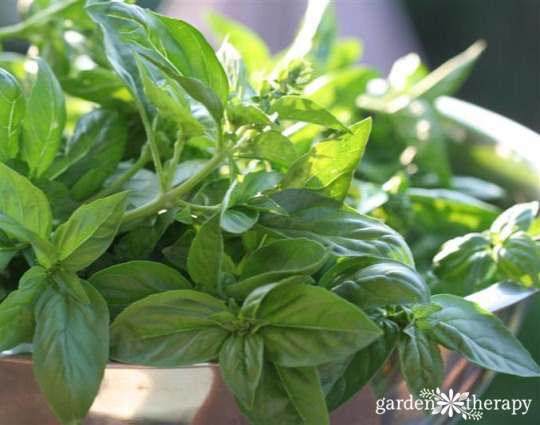
Ah, basil! The topping of a Margherita pizza, the base to pasta slathered in pesto, and the intensity behind Thai coconut curry. What’s not to love? Grow this fresh and bold herb for yourself to really make your cooking taste that much better. Here’s how to grow basil at home! If I asked you to name a herb, I bet you basil would be one of the first words that pop into your head. People absolutely love basil, and it’s quickly become a staple in Western cuisine in the past few decades. When you go to the grocery store, you’ll likely see sweet basil, Ocimum basilicum, for sale. While it is the most popular basil nowadays, it’s far from the only type out there. Thai basil and holy basil are some other favourites. The basil found at the grocery store may only be a few bucks, but with that same amount of money, you could buy a packet of seeds for endless, big bushes of basil. Plus, the stuff you grow yourself will taste infinitely better and sweeter. I promise you! So without further adieu, here’s how to grow basil yourself using five different methods. Jump ahead to… Expert Tips for Growing Basil Sweet basil, Ocimum basilicum, is the most common culinary basil found in the grocery store. You can easily grow basil by dividing an existing basil plant from the grocery store or by taking cuttings of it and placing it in water. Basil can be grown from seed as well. It’s best to start it indoors using a heat mat, then transplant it outside once the threat of frost has passed. Basil likes heat, so be sure to place it somewhere where it gets 6-8 hours of full sunlight daily. While growing, pinch the top parts of the basil off whenever you harvest to encourage a bushier shape. Separate existing basil plants for bigger, healthier growth. History of Basil Basil is a herbaceous plant that belongs to the mint family. In most parts of the world, it grows as an annual because it’s not frost tolerant. It originates from India and Africa but is now found globally. In Indian culture, basil is a spiritual symbol that was used in spiritual offerings and as a household medicine. Holy basil, also known as Tulsi, was sacred to the Hindu god Vishnu, hence the name. In ancient Indian texts, the plant was written as a snakebite and scorpion sting treatment. In Greece, basil represented mourning and was a part of funeral rituals. It remains a large part of Mediterranean cuisine, especially known for topping pizzas and as the base for pesto. Basil can be found in the lowland regions of India through Bangladesh and Thailand to southern China. It’s also a key player in Indonesian, Thai, and Vietnamese cuisine, particularly Thai basil. Check out this post to learn more about basil’s fascinating history. One single stem of basil can be propagated into a new plant. Health Benefits of Basil Ayurvedic, Traditional Chinese Medicine, and other holistic practices use basil for its health benefits. The most notable type of basil used for health is holy basil (Ocimum sanctum and O. gratissimum). However, some herbalists say that common sweet basil has similar medicinal effects. Holy basil works as a nervine, stimulating the body but then bringing a sense of calm. They may seem contradictory, but it works well together. The basil moves any blocked energy and dispels sluggishness, bringing a feeling of calm. This is also why it can help with depression. Holy basil also works as a warming and cooling agent. It’s known to help with respiratory ailments thanks to being antiviral, antibacterial, diaphoretic, and a decongestant. In Indian, holy basil is commonly used to help with indigestion and vomiting, helping to stimulate appetite and digestion. In Western herbalism, it is used as an adaptogen, which is used to help the body’s stress response and the negative effects that come from stress. It’s also shown promise in aiding in liver health, fighting cancer, and reducing blood sugar for those with diabetes. Most studies surrounding basil center around extracts, so you may not get these health benefits from sprinkling the herb or making tea alone. How to Grow Basil If you buy basil in the store, it tends to be smaller plants that taste a little bit bitter and isn’t as sweet as garden-fresh basil. That’s because there are a whole bunch of plants crowded into those pots! You can bring them home to plant in your garden, and it will be much happier and sweeter. But why? Because basil will grow to be quite large in the garden. Grocery store herbs are in tiny pots, or worse, cut from the roots and placed in a plastic clamshell package. The herb pots are the ones I will often pick up when I see them because they house many small plants that are grown from seeds and can be transplanted into the garden or a pot at home. Dividing Grocery Store Basil Plants Give your basil plants more space to grow by separating them. Here’s how. Grab the bunch of plants and pull them out to expose the root ball. Gently tease apart the roots for each of the plants. When you pull a plant out of the cluster with a nice, healthy root system, plant it in your garden. You may harvest your basil as you need it throughout the season. It will have the most flavour before it flowers. By following this process, you’ll grow amazing basil that you can use all summer long and then preserve it to use over the cold months too. See how many single basil plants have been jam-packed in this pot? How to Grow Basil From Cuttings Another one of the easiest ways to grow basil is from cuttings. You can take these cuttings from an existing basil plant, whether that’s the one you picked up from the grocery store or a clipping from your neighbour’s front yard. To make a cutting, snip the basil stem, ensuring it has at least four sets of leaves. Remove the bottom two sets of leaves, and then place it in a glass of water. Let the glass sit in a sunny spot. When the roots are visible, it���s ready to be transferred into the soil. When the roots are at least 1 cm long, you can transplant it to soil. How to Grow Basil from Seeds Of course, you can also grow basil from seed. People like to grow basil from seed since you have many more varieties to choose from and can grow a ton of basil at once (for those of you who love pesto!). Growing it this way is also much cheaper, as one packet of seeds will go a long way. Most of us who experience some kind of winter want to grow the seeds indoors. You can do this using a sunny windowsill, a grow light set up, or a heat mat if you’ve got one. Start off by using a seed-starting soil mix and your container of choice. I tend to make my own with soil blocks or just reuse plastic cells. Moisten the soil before adding it to your seed starting container of choice. Plant 2-3 seeds per cell. Top it off with a clear dome (any clear plastic container works) to help it germinate. Basil likes heat, so make sure it’s getting some. Consider placing a fan nearby it on low as well to prevent damping off. As they grow, thin them out. You can transplant them outside once the threat of frost has passed. Harden them off for a few days by placing the seedling containers outside before planting them in the ground or in a new container. Direct Sowing Basil Seeds You can also sow basil seeds directly in the ground. But since basil likes heat, only those in zone 6 or higher should attempt this. Even then, it should be in late spring or early summer, at least two weeks after the last frost. The soil temperature should be about 70°F. Basil is an excellent companion plant, doing exceptionally well alongside tomatoes and peppers. How to Grow Basil Indoors If you want basil year-round, you can grow it inside as well. I will say it’s a little trickier than other herbs to grow indoors since it likes to be in the ground where it gets lots of sun and get big. So rule number one, keep it somewhere extra sunny. Make sure you plant it in a container with drainage holes to avoid soaking the roots. Pinch it to promote it getting bushier. And when it gets too leggy, simply cut off a few sprigs and start the basil from cuttings all over again. I would highly recommend having a little countertop garden for your herbs, as this ensures it’s easily accessible when you’re cooking, and it gets enough light from the grow lights to actually make it indoors. I grew this Purple Ruffles basil inside right at my window. Ideal Conditions for Growing Basil Sun: as sun lovers, basil needs 6-8 hours a day of full sun. In hot climates, you may need to shelter your basil from the hot afternoon heat. However, basil likes heat, so don’t put it out too early in the season when the nights can still get cold. Water: give your basil a moderate amount of water. It isn’t super thirsty but isn’t drought tolerant, either. Soil: basil likes well-drained soil so it doesn’t have wet feet. Before planting, add some compost to improve the soil. Fertilizer: I don’t typically fertilize any plants that grow in my beds, as the surrounding soil already has enough nutrients. The compost you routinely add will also make a big difference. But if you grow basil in containers, you’ll need to fertilize every other week during the growing season. Harvest too much basil? Place it in a glass of water; it should keep well for a couple of days…until it starts growing roots! Harvesting Basil The key to getting a big, round basil plant is to pinch it often. This means you take off the top leaders. AKA, you’re harvesting as you go! Don’t pluck the leaves; instead, remove the whole stem. Avoid letting the basil flower, as it won’t taste as good once it does. However, if you can spare a basil or two, the bees do love the flowers. Basil is best fresh, but you can use it in plenty of ways. Here are 16 ideas to use up your basil! And when you have a lot left and the season is nearing an end, you can dry the basil throughout the winter in your cooking. After you harvest a stem, remove the individual leaves. Frequently Asked Questions About Basil How long does it take basil to grow? Seeds take 5-10 days to sprout. Then, they’re ready for transplant after 4-6 weeks. You can harvest them quite early, about the same time that they’re ready to be transplanted. Just ensure you don’t take more than 1/3 of the plant at a time. In fact, frequent harvests can prolong the lifespan of your basil.Learn more about the proper time to plant herbs. Basil can get quite big and bushy if you pinch it while it grows. Happy planting! Let me know if you have any more basil growing questions in the comments below. More Things to Know About Basil A city girl who learned to garden and it changed everything. Author, artist, Master Gardener. Better living through plants. Source link
#WATERING_SYSTEMS#BASIL#GARDEN#GROW#GROWING_FOOD#GROWING_GUIDE#HERBS#INDOOR_GARDENING#METHODS#MONTH_MAY_WEEK_2#THERAPY
0 notes
Photo
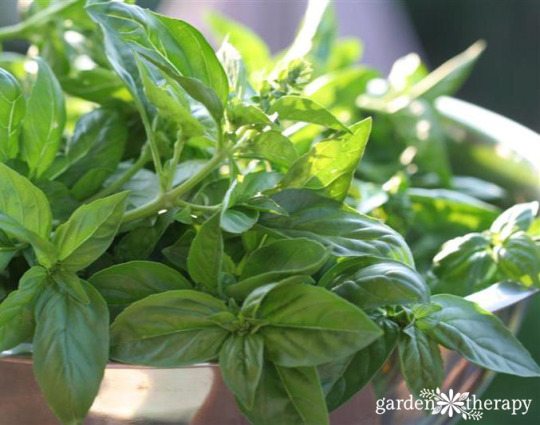
Ah, basil! The topping of a Margherita pizza, the base to pasta slathered in pesto, and the intensity behind Thai coconut curry. What’s not to love? Grow this fresh and bold herb for yourself to really make your cooking taste that much better. Here’s how to grow basil at home! If I asked you to name a herb, I bet you basil would be one of the first words that pop into your head. People absolutely love basil, and it’s quickly become a staple in Western cuisine in the past few decades. When you go to the grocery store, you’ll likely see sweet basil, Ocimum basilicum, for sale. While it is the most popular basil nowadays, it’s far from the only type out there. Thai basil and holy basil are some other favourites. The basil found at the grocery store may only be a few bucks, but with that same amount of money, you could buy a packet of seeds for endless, big bushes of basil. Plus, the stuff you grow yourself will taste infinitely better and sweeter. I promise you! So without further adieu, here’s how to grow basil yourself using five different methods. Jump ahead to… Expert Tips for Growing Basil Sweet basil, Ocimum basilicum, is the most common culinary basil found in the grocery store. You can easily grow basil by dividing an existing basil plant from the grocery store or by taking cuttings of it and placing it in water. Basil can be grown from seed as well. It’s best to start it indoors using a heat mat, then transplant it outside once the threat of frost has passed. Basil likes heat, so be sure to place it somewhere where it gets 6-8 hours of full sunlight daily. While growing, pinch the top parts of the basil off whenever you harvest to encourage a bushier shape. Separate existing basil plants for bigger, healthier growth. History of Basil Basil is a herbaceous plant that belongs to the mint family. In most parts of the world, it grows as an annual because it’s not frost tolerant. It originates from India and Africa but is now found globally. In Indian culture, basil is a spiritual symbol that was used in spiritual offerings and as a household medicine. Holy basil, also known as Tulsi, was sacred to the Hindu god Vishnu, hence the name. In ancient Indian texts, the plant was written as a snakebite and scorpion sting treatment. In Greece, basil represented mourning and was a part of funeral rituals. It remains a large part of Mediterranean cuisine, especially known for topping pizzas and as the base for pesto. Basil can be found in the lowland regions of India through Bangladesh and Thailand to southern China. It’s also a key player in Indonesian, Thai, and Vietnamese cuisine, particularly Thai basil. Check out this post to learn more about basil’s fascinating history. One single stem of basil can be propagated into a new plant. Health Benefits of Basil Ayurvedic, Traditional Chinese Medicine, and other holistic practices use basil for its health benefits. The most notable type of basil used for health is holy basil (Ocimum sanctum and O. gratissimum). However, some herbalists say that common sweet basil has similar medicinal effects. Holy basil works as a nervine, stimulating the body but then bringing a sense of calm. They may seem contradictory, but it works well together. The basil moves any blocked energy and dispels sluggishness, bringing a feeling of calm. This is also why it can help with depression. Holy basil also works as a warming and cooling agent. It’s known to help with respiratory ailments thanks to being antiviral, antibacterial, diaphoretic, and a decongestant. In Indian, holy basil is commonly used to help with indigestion and vomiting, helping to stimulate appetite and digestion. In Western herbalism, it is used as an adaptogen, which is used to help the body’s stress response and the negative effects that come from stress. It’s also shown promise in aiding in liver health, fighting cancer, and reducing blood sugar for those with diabetes. Most studies surrounding basil center around extracts, so you may not get these health benefits from sprinkling the herb or making tea alone. How to Grow Basil If you buy basil in the store, it tends to be smaller plants that taste a little bit bitter and isn’t as sweet as garden-fresh basil. That’s because there are a whole bunch of plants crowded into those pots! You can bring them home to plant in your garden, and it will be much happier and sweeter. But why? Because basil will grow to be quite large in the garden. Grocery store herbs are in tiny pots, or worse, cut from the roots and placed in a plastic clamshell package. The herb pots are the ones I will often pick up when I see them because they house many small plants that are grown from seeds and can be transplanted into the garden or a pot at home. Dividing Grocery Store Basil Plants Give your basil plants more space to grow by separating them. Here’s how. Grab the bunch of plants and pull them out to expose the root ball. Gently tease apart the roots for each of the plants. When you pull a plant out of the cluster with a nice, healthy root system, plant it in your garden. You may harvest your basil as you need it throughout the season. It will have the most flavour before it flowers. By following this process, you’ll grow amazing basil that you can use all summer long and then preserve it to use over the cold months too. See how many single basil plants have been jam-packed in this pot? How to Grow Basil From Cuttings Another one of the easiest ways to grow basil is from cuttings. You can take these cuttings from an existing basil plant, whether that’s the one you picked up from the grocery store or a clipping from your neighbour’s front yard. To make a cutting, snip the basil stem, ensuring it has at least four sets of leaves. Remove the bottom two sets of leaves, and then place it in a glass of water. Let the glass sit in a sunny spot. When the roots are visible, it’s ready to be transferred into the soil. When the roots are at least 1 cm long, you can transplant it to soil. How to Grow Basil from Seeds Of course, you can also grow basil from seed. People like to grow basil from seed since you have many more varieties to choose from and can grow a ton of basil at once (for those of you who love pesto!). Growing it this way is also much cheaper, as one packet of seeds will go a long way. Most of us who experience some kind of winter want to grow the seeds indoors. You can do this using a sunny windowsill, a grow light set up, or a heat mat if you’ve got one. Start off by using a seed-starting soil mix and your container of choice. I tend to make my own with soil blocks or just reuse plastic cells. Moisten the soil before adding it to your seed starting container of choice. Plant 2-3 seeds per cell. Top it off with a clear dome (any clear plastic container works) to help it germinate. Basil likes heat, so make sure it’s getting some. Consider placing a fan nearby it on low as well to prevent damping off. As they grow, thin them out. You can transplant them outside once the threat of frost has passed. Harden them off for a few days by placing the seedling containers outside before planting them in the ground or in a new container. Direct Sowing Basil Seeds You can also sow basil seeds directly in the ground. But since basil likes heat, only those in zone 6 or higher should attempt this. Even then, it should be in late spring or early summer, at least two weeks after the last frost. The soil temperature should be about 70°F. Basil is an excellent companion plant, doing exceptionally well alongside tomatoes and peppers. How to Grow Basil Indoors If you want basil year-round, you can grow it inside as well. I will say it’s a little trickier than other herbs to grow indoors since it likes to be in the ground where it gets lots of sun and get big. So rule number one, keep it somewhere extra sunny. Make sure you plant it in a container with drainage holes to avoid soaking the roots. Pinch it to promote it getting bushier. And when it gets too leggy, simply cut off a few sprigs and start the basil from cuttings all over again. I would highly recommend having a little countertop garden for your herbs, as this ensures it’s easily accessible when you’re cooking, and it gets enough light from the grow lights to actually make it indoors. I grew this Purple Ruffles basil inside right at my window. Ideal Conditions for Growing Basil Sun: as sun lovers, basil needs 6-8 hours a day of full sun. In hot climates, you may need to shelter your basil from the hot afternoon heat. However, basil likes heat, so don’t put it out too early in the season when the nights can still get cold. Water: give your basil a moderate amount of water. It isn’t super thirsty but isn’t drought tolerant, either. Soil: basil likes well-drained soil so it doesn’t have wet feet. Before planting, add some compost to improve the soil. Fertilizer: I don’t typically fertilize any plants that grow in my beds, as the surrounding soil already has enough nutrients. The compost you routinely add will also make a big difference. But if you grow basil in containers, you’ll need to fertilize every other week during the growing season. Harvest too much basil? Place it in a glass of water; it should keep well for a couple of days…until it starts growing roots! Harvesting Basil The key to getting a big, round basil plant is to pinch it often. This means you take off the top leaders. AKA, you’re harvesting as you go! Don’t pluck the leaves; instead, remove the whole stem. Avoid letting the basil flower, as it won’t taste as good once it does. However, if you can spare a basil or two, the bees do love the flowers. Basil is best fresh, but you can use it in plenty of ways. Here are 16 ideas to use up your basil! And when you have a lot left and the season is nearing an end, you can dry the basil throughout the winter in your cooking. After you harvest a stem, remove the individual leaves. Frequently Asked Questions About Basil How long does it take basil to grow? Seeds take 5-10 days to sprout. Then, they’re ready for transplant after 4-6 weeks. You can harvest them quite early, about the same time that they’re ready to be transplanted. Just ensure you don’t take more than 1/3 of the plant at a time. In fact, frequent harvests can prolong the lifespan of your basil.Learn more about the proper time to plant herbs. Basil can get quite big and bushy if you pinch it while it grows. Happy planting! Let me know if you have any more basil growing questions in the comments below. More Things to Know About Basil A city girl who learned to garden and it changed everything. Author, artist, Master Gardener. Better living through plants. Source link
#WATERING_SYSTEMS#BASIL#GARDEN#GROW#GROWING_FOOD#GROWING_GUIDE#HERBS#INDOOR_GARDENING#METHODS#MONTH_MAY_WEEK_2#THERAPY
0 notes
Photo

Ah, basil! The topping of a Margherita pizza, the base to pasta slathered in pesto, and the intensity behind Thai coconut curry. What’s not to love? Grow this fresh and bold herb for yourself to really make your cooking taste that much better. Here’s how to grow basil at home! If I asked you to name a herb, I bet you basil would be one of the first words that pop into your head. People absolutely love basil, and it’s quickly become a staple in Western cuisine in the past few decades. When you go to the grocery store, you’ll likely see sweet basil, Ocimum basilicum, for sale. While it is the most popular basil nowadays, it’s far from the only type out there. Thai basil and holy basil are some other favourites. The basil found at the grocery store may only be a few bucks, but with that same amount of money, you could buy a packet of seeds for endless, big bushes of basil. Plus, the stuff you grow yourself will taste infinitely better and sweeter. I promise you! So without further adieu, here’s how to grow basil yourself using five different methods. Jump ahead to… Expert Tips for Growing Basil Sweet basil, Ocimum basilicum, is the most common culinary basil found in the grocery store. You can easily grow basil by dividing an existing basil plant from the grocery store or by taking cuttings of it and placing it in water. Basil can be grown from seed as well. It’s best to start it indoors using a heat mat, then transplant it outside once the threat of frost has passed. Basil likes heat, so be sure to place it somewhere where it gets 6-8 hours of full sunlight daily. While growing, pinch the top parts of the basil off whenever you harvest to encourage a bushier shape. Separate existing basil plants for bigger, healthier growth. History of Basil Basil is a herbaceous plant that belongs to the mint family. In most parts of the world, it grows as an annual because it’s not frost tolerant. It originates from India and Africa but is now found globally. In Indian culture, basil is a spiritual symbol that was used in spiritual offerings and as a household medicine. Holy basil, also known as Tulsi, was sacred to the Hindu god Vishnu, hence the name. In ancient Indian texts, the plant was written as a snakebite and scorpion sting treatment. In Greece, basil represented mourning and was a part of funeral rituals. It remains a large part of Mediterranean cuisine, especially known for topping pizzas and as the base for pesto. Basil can be found in the lowland regions of India through Bangladesh and Thailand to southern China. It’s also a key player in Indonesian, Thai, and Vietnamese cuisine, particularly Thai basil. Check out this post to learn more about basil’s fascinating history. One single stem of basil can be propagated into a new plant. Health Benefits of Basil Ayurvedic, Traditional Chinese Medicine, and other holistic practices use basil for its health benefits. The most notable type of basil used for health is holy basil (Ocimum sanctum and O. gratissimum). However, some herbalists say that common sweet basil has similar medicinal effects. Holy basil works as a nervine, stimulating the body but then bringing a sense of calm. They may seem contradictory, but it works well together. The basil moves any blocked energy and dispels sluggishness, bringing a feeling of calm. This is also why it can help with depression. Holy basil also works as a warming and cooling agent. It’s known to help with respiratory ailments thanks to being antiviral, antibacterial, diaphoretic, and a decongestant. In Indian, holy basil is commonly used to help with indigestion and vomiting, helping to stimulate appetite and digestion. In Western herbalism, it is used as an adaptogen, which is used to help the body’s stress response and the negative effects that come from stress. It’s also shown promise in aiding in liver health, fighting cancer, and reducing blood sugar for those with diabetes. Most studies surrounding basil center around extracts, so you may not get these health benefits from sprinkling the herb or making tea alone. How to Grow Basil If you buy basil in the store, it tends to be smaller plants that taste a little bit bitter and isn’t as sweet as garden-fresh basil. That’s because there are a whole bunch of plants crowded into those pots! You can bring them home to plant in your garden, and it will be much happier and sweeter. But why? Because basil will grow to be quite large in the garden. Grocery store herbs are in tiny pots, or worse, cut from the roots and placed in a plastic clamshell package. The herb pots are the ones I will often pick up when I see them because they house many small plants that are grown from seeds and can be transplanted into the garden or a pot at home. Dividing Grocery Store Basil Plants Give your basil plants more space to grow by separating them. Here’s how. Grab the bunch of plants and pull them out to expose the root ball. Gently tease apart the roots for each of the plants. When you pull a plant out of the cluster with a nice, healthy root system, plant it in your garden. You may harvest your basil as you need it throughout the season. It will have the most flavour before it flowers. By following this process, you’ll grow amazing basil that you can use all summer long and then preserve it to use over the cold months too. See how many single basil plants have been jam-packed in this pot? How to Grow Basil From Cuttings Another one of the easiest ways to grow basil is from cuttings. You can take these cuttings from an existing basil plant, whether that’s the one you picked up from the grocery store or a clipping from your neighbour’s front yard. To make a cutting, snip the basil stem, ensuring it has at least four sets of leaves. Remove the bottom two sets of leaves, and then place it in a glass of water. Let the glass sit in a sunny spot. When the roots are visible, it’s ready to be transferred into the soil. When the roots are at least 1 cm long, you can transplant it to soil. How to Grow Basil from Seeds Of course, you can also grow basil from seed. People like to grow basil from seed since you have many more varieties to choose from and can grow a ton of basil at once (for those of you who love pesto!). Growing it this way is also much cheaper, as one packet of seeds will go a long way. Most of us who experience some kind of winter want to grow the seeds indoors. You can do this using a sunny windowsill, a grow light set up, or a heat mat if you’ve got one. Start off by using a seed-starting soil mix and your container of choice. I tend to make my own with soil blocks or just reuse plastic cells. Moisten the soil before adding it to your seed starting container of choice. Plant 2-3 seeds per cell. Top it off with a clear dome (any clear plastic container works) to help it germinate. Basil likes heat, so make sure it’s getting some. Consider placing a fan nearby it on low as well to prevent damping off. As they grow, thin them out. You can transplant them outside once the threat of frost has passed. Harden them off for a few days by placing the seedling containers outside before planting them in the ground or in a new container. Direct Sowing Basil Seeds You can also sow basil seeds directly in the ground. But since basil likes heat, only those in zone 6 or higher should attempt this. Even then, it should be in late spring or early summer, at least two weeks after the last frost. The soil temperature should be about 70°F. Basil is an excellent companion plant, doing exceptionally well alongside tomatoes and peppers. How to Grow Basil Indoors If you want basil year-round, you can grow it inside as well. I will say it’s a little trickier than other herbs to grow indoors since it likes to be in the ground where it gets lots of sun and get big. So rule number one, keep it somewhere extra sunny. Make sure you plant it in a container with drainage holes to avoid soaking the roots. Pinch it to promote it getting bushier. And when it gets too leggy, simply cut off a few sprigs and start the basil from cuttings all over again. I would highly recommend having a little countertop garden for your herbs, as this ensures it’s easily accessible when you’re cooking, and it gets enough light from the grow lights to actually make it indoors. I grew this Purple Ruffles basil inside right at my window. Ideal Conditions for Growing Basil Sun: as sun lovers, basil needs 6-8 hours a day of full sun. In hot climates, you may need to shelter your basil from the hot afternoon heat. However, basil likes heat, so don’t put it out too early in the season when the nights can still get cold. Water: give your basil a moderate amount of water. It isn’t super thirsty but isn’t drought tolerant, either. Soil: basil likes well-drained soil so it doesn’t have wet feet. Before planting, add some compost to improve the soil. Fertilizer: I don’t typically fertilize any plants that grow in my beds, as the surrounding soil already has enough nutrients. The compost you routinely add will also make a big difference. But if you grow basil in containers, you’ll need to fertilize every other week during the growing season. Harvest too much basil? Place it in a glass of water; it should keep well for a couple of days…until it starts growing roots! Harvesting Basil The key to getting a big, round basil plant is to pinch it often. This means you take off the top leaders. AKA, you’re harvesting as you go! Don’t pluck the leaves; instead, remove the whole stem. Avoid letting the basil flower, as it won’t taste as good once it does. However, if you can spare a basil or two, the bees do love the flowers. Basil is best fresh, but you can use it in plenty of ways. Here are 16 ideas to use up your basil! And when you have a lot left and the season is nearing an end, you can dry the basil throughout the winter in your cooking. After you harvest a stem, remove the individual leaves. Frequently Asked Questions About Basil How long does it take basil to grow? Seeds take 5-10 days to sprout. Then, they’re ready for transplant after 4-6 weeks. You can harvest them quite early, about the same time that they’re ready to be transplanted. Just ensure you don’t take more than 1/3 of the plant at a time. In fact, frequent harvests can prolong the lifespan of your basil.Learn more about the proper time to plant herbs. Basil can get quite big and bushy if you pinch it while it grows. Happy planting! Let me know if you have any more basil growing questions in the comments below. More Things to Know About Basil A city girl who learned to garden and it changed everything. Author, artist, Master Gardener. Better living through plants. Source link
#WATERING_SYSTEMS#BASIL#GARDEN#GROW#GROWING_FOOD#GROWING_GUIDE#HERBS#INDOOR_GARDENING#METHODS#MONTH_MAY_WEEK_2#THERAPY
0 notes